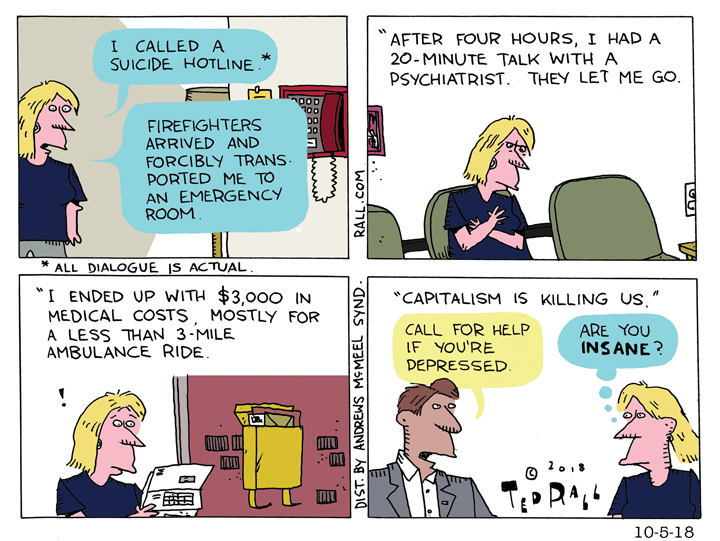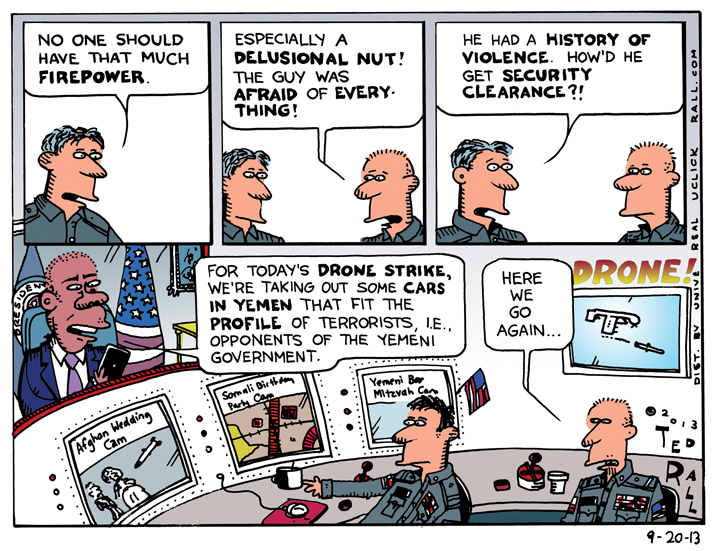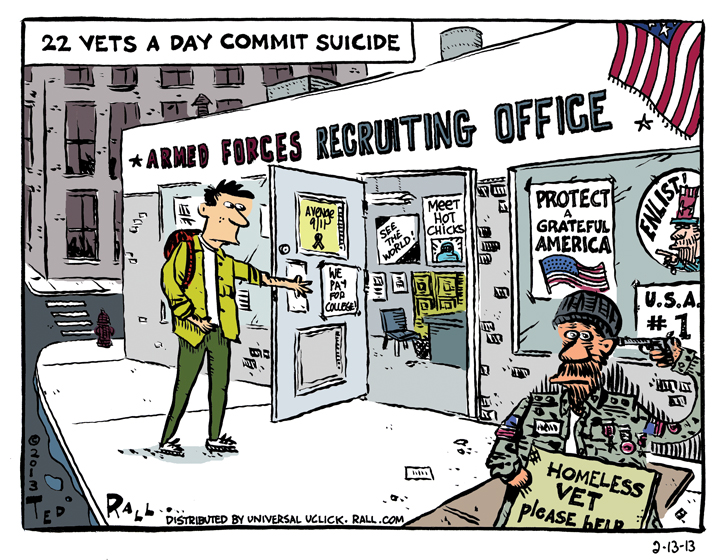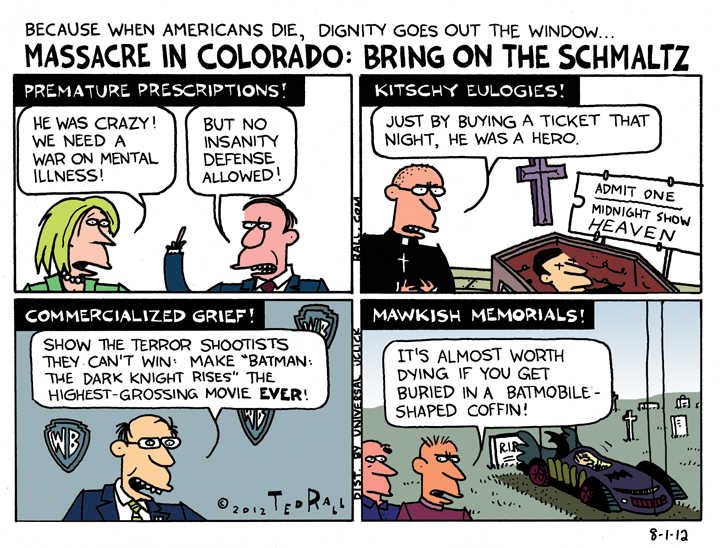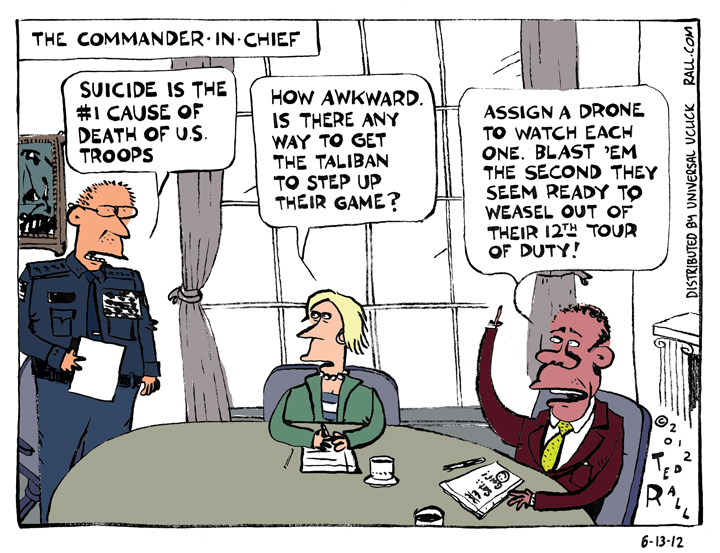Why don’t more victims of depression call for help? Some people who do wind up not with help but a giant medical bill.
SYNDICATED COLUMN: Suicide? No. Society Is Murdering Us. But There Is a Way Out.

They say that 10 million Americans seriously consider committing suicide every year. In 1984, when I was 20, I was one of them.
Most people who kill themselves feel hopeless. They are miserable and distraught and can’t imagine how or if their lives will ever improve. That’s how I felt. Within a few months I got expelled from college, dumped by a girlfriend I foolishly believed I would marry, fired from my job and evicted from my apartment. I was homeless, bereft, broke. I didn’t have enough money for more than a day of cheap food. And I had no prospects.
I tried in vain to summon up the guts to jump off the roof of my dorm. I went down to the subway but couldn’t make myself jump in front of a train. I wanted to. But I couldn’t.
Obviously things got better. I’m writing this.
Things got better because my luck changed. But — why did it have to? Isn’t there something wrong with a society in which life or death turns on luck?
I wish I could tell my 20-year-old self that suicide isn’t necessary, that there is another way, that there will be plenty of time to be dead in the end. I’ve seen those other ways when I’ve traveled overseas.
In Thailand and Central Asia and the Caribbean and all over the world you will find Americans whose American lives ran hard against the shoals of bankruptcy, lost love, addiction or social shame. Rather than off themselves, they gathered their last dollars and headed to the airport and went somewhere else to start over. They showed up at some dusty ex-pat bar in the middle of nowhere with few skills other than speaking English and asked if they could crash in the back room in between washing dishes. Eventually they scraped together enough money to conduct tours for Western tourists, maybe working as a divemaster or taking rich vacationers deep-sea fishing. They weren’t rich themselves; they were OK and that was more than enough.
You really can start over. But maybe not in this uptight, stuck-up, class-stratified country.
I remembered that in 2015 when I suffered another setback. Unbeknownst to me, the Los Angeles Times — where I had worked as a cartoonist since 2009 – had gotten itself into a corrupt business deal with the LAPD, which I routinely criticized in my cartoons. A piece-of-work police chief leveraged his department’s financial influence on the newspaper by demanding that the idiot ingénue publisher, his political ally, fire me as a favor. But mere firing wasn’t enough for these two goons. They published not one, but two articles, lying about me in an outrageous attempt to destroy my journalistic credibility. I’m suing but the court system is slower than molasses in the pre-climate change Arctic.
Suicide crossed my mind many times during those dark weeks and months. Although I had done nothing wrong the Times’ smears made me feel ashamed. I was angry: at the Times editors who should have quit rather than carry out such shameful orders, at the media outlets who refused to cover my story, at the friends and colleagues who didn’t support me. Though many people stood by me, I felt alone. I couldn’t imagine salvaging my reputation — as a journalist, your reputation for truthtelling and integrity are your most valuable asset and essential to do your job and to get new ones.
As my LA Times nightmare unfolded, however, I remembered the Texas-born bartender who had reinvented himself in Belize after his wife left him and a family court judge ordered him to pay 90% of his salary in alimony. I thought about the divemaster in Cozumel running away from legal trouble back in the States that he refused to describe. If my career were to crumble away, I could split.
You can opt out of BS without having to opt out of life.
Up 30% since 1999, suicide has become an accelerating national epidemic — 1.4 million Americans tried to kill themselves in a single year, 2015 — but the only times the media focuses on suicide is when it claims the lives of celebrities like Kate Spade and Anthony Bourdain. While the media has made inroads by trying to cover high-profile suicides discreetly so as to minimize suicidal ideation and inspiring others to follow their example, it’s frustrating that no one seems to want to identify societal and political factors so that this trend might be reversed.
Experts believe that roughly half of men who commit suicide suffer from undiagnosed mental illness such as a severe personality disorder or clinical depression. Men commit suicide in substantially higher numbers than women. The healthcare insurance business isn’t much help. One in five Americans is mentally ill but 60% get no treatment at all.
Then there’s stress. Journalistic outlets and politicians don’t target the issue of stress in any meaningful way other than to foolishly, insipidly advise people to avoid it. If you subject millions of people to inordinate stress, some of them, the fragile ones, will take their own lives. We should be working to create a society that minimizes rather than increases stress.
It doesn’t require a lot of heavy lifting to come up with major sources of stress in American society. People are working longer hours but earning lower pay. Even people with jobs are terrified of getting laid off without a second’s notice. The American healthcare system, designed to fatten for-profit healthcare corporations, is a sick joke. When you lose your job or get sick, that shouldn’t be your problem alone. We’re social creatures. We must help each other personally, locally and through strong safety-net social programs.
Loneliness and isolation are likely leading causes of suicide; technology is alienating us from one another even from those who live in our own homes. This is a national emergency. We have to discuss it, then act.
Life in the United States has become vicious and brutal, too much to take even for this nation founded upon the individualistic principles of rugged libertarian pioneers. Children are pressured to exhibit fake joy and success on social media. Young adults are burdened with gigantic student loans they strongly suspect they will never be able to repay. The middle-aged are divorced, outsourced, downsized and repeatedly told they are no longer relevant. And the elderly are thrown away or warehoused, discarded and forgotten by the children they raised.
We don’t have to live this way. It’s a choice. Like the American ex-pats I run into overseas, American society can opt out of crazy-making capitalism without having to opt out.
SYNDICATED COLUMN: On the One Hand, Gun Violence. On the Other Hand, Gun Control. It Never Ends.

On the one hand, the news that another psychologically damaged man shot 17 schoolchildren to death with an AR-15 semiautomatic rifle is not news. Put it on page 27 below the fold, maybe?
On the other hand, you have to be shocked because these are kids and who do we become if we stop being shocked? Congress and the president should put their heads together and act now.
On the one hand, the Second Amendment is an essential safeguard against government tyranny. While an authoritarian state (any state) will always have police and troops with better training and arms than its enemies at its disposal, owning a weapon will give many resistance fighters of the future the courage they need to fight back.
On the other hand, the population of Americans who live in rural areas was 95% when the Founding Fathers ratified the Constitution. Now it’s 15%. Once a major source of food necessary for survival, hunting today is mere sport. Considering the daily carnage of gun violence, the Second Amendment may be as obsolete as the flint-lock rifle. Perhaps we should repeal?
On the one hand, military-style weapons like the current mass shooters’ gun of choice, the AR-15, were designed for one purpose: to kill people efficiently. Until 2008 they were banned. Why not renew the assault weapons ban?
On the other hand, people really do use them to hunt. Having been on the receiving end of more than my fair share of death threats, I’d rather defend my homestead with an AR-15 than a less efficient, less accurate gun. Sorry, liberals, but gun rights people have a point: ban AR-15s and the next step will be a push to ban other weapons. Slippery slopes are a real thing; look how the pro-life movement has rolled back abortion rights via incremental, reasonable-seeming moves like bans on late-term terminations.
On the one hand, there are 270 million guns in the United States — almost one for every man, woman and child. Even if we banned guns, how would we force the gun genie back into its bottle of death? Send government goons to kick down every door in the country to search for them?
On the other hand, existing guns could be grandfathered into a ban on the manufacture and sale of new guns (including from one individual to another). Guns would get old. They’d rust. Those used for target practice would wear out. Trigger mechanisms are often the first to go. Like the fairly effective ban on ivory, the effect would become evident over time: a nation awash in weaponry would become less so with the passage of time.
On the one hand, states like Florida seem crazy for not requiring gun purchasers to register their weapons. Florida actually bans such regulations. Cars, boats, even bicycles and cats and dogs, must be registered. Why not devices that kill people?
On the other hand, gun ownership is different. It’s a constitutional right. Automobile ownership, operating a boat and having a pet are privileges guaranteed by state and local laws. Mandatory gun registration would be no more constitutional than forcing media outlets to apply for a state license before publishing (they do this in other countries).
On the one hand, many if not most mass shooters are mentally ill. Wouldn’t it make sense to prohibit sales of firearms and ammunition to people suffering from mental illness?
On the other hand, who gets to define what constitutes mental illness? Federal law bans sales to anyone who “has been adjudicated as a mental defective or has been committed to any mental institution.” New York, where I live, goes further, banning sales of guns to one “who has stated whether he or she has ever suffered any mental illness.” That’s very broad: “Heathers” and “Stranger Things” actress Winona Ryder, singer Mariah Carey, artist Yoko Ono and actress Roseanne Barr were all institutionalized. But no one thinks they’re going postal any time soon — frankly, I’d trust Winona with the nuclear codes more than Trump. The metric is also highly subjective. Gays were officially classified as mentally ill until 1987. Transgender people are still on the list.
On the one hand, people who knew him say they’re not surprised that Florida shooter Nikolas Cruz went berserk. The signs were there all along: violent Internet posts, ties to white supremacists, erratic behavior like threatening people with a BB gun. People saw something; why didn’t they say something?
On the other hand, this isn’t “Minority Report.” You can’t jail someone for what they might do. People are entitled to their opinions, no matter what they are. If you jailed everyone who acts strange or right-wing or loopy, half the country would be locked up. And anyway, who trusts the police or the government to decide which half?
On the one hand, if anyone deserves to die, it’s Nikolas Cruz.
On the other hand, what kind of society executes a “broken child,” possibly autistic, almost certainly emotionally damaged, absolutely wrecked by the recent death of his mother, his last surviving parent?
How does killing a killer send the message that killing is wrong?
(Ted Rall (Twitter: @tedrall) is co-author, with Harmon Leon, of “Meet the Deplorables: Infiltrating Trump America,” an inside look at the American far right, out now. You can support Ted’s hard-hitting political cartoons and columns and see his work first by sponsoring his work on Patreon.)
CORRECTION: This piece has been corrected by the deletion of “because it’s the 18th school shooting so far this year, ” from the first sentence. I fell victim to a widely disseminated, now known to be untrue, statistic. Please see The Washington Post here for details.
SYNDICATED COLUMN: Germanwings Mass Murder-Suicide Caused by Punitive Rules, Coldhearted Capitalism

Investigators are still putting together the pieces, but from what we know so far, it’s likely that 27-year-old German co-pilot Andreas Lubitz committed mass murder-suicide when he flew a Germanwings passenger jet carrying 149 passengers and fellow crewmen into the French Alps.
Authorities say they haven’t found a suicide note, but it’s a safe bet that Lubitz’s final act was prompted by depression (they found the meds), diminished vision, a deteriorating romantic relationship and his worry that the Lufthansa subsidiary would ground him if they found out about his problems, crashing a career he loved and blowing up his livelihood.
Though rare, pilot suicide isn’t unheard of. As long as the current system remains in place, it will happen again.
By “system,” I’m referring both to specific rules issued by the FAA and other countries’ aviation authorities to regulate pilots, and to that most coldhearted of socioeconomic systems, you’re-on-your-own capitalism.
“Before they are licensed, pilots must undergo a medical exam, conducted by a doctor trained and certified by the aviation agency,” explains The New York Times. Some airlines impose additional screening procedures, but they vary from company to company. Active pilots are required to have a medical screening once a year until they turn 40 and then twice a year after. Only when pilots are found to have mental health problems are they sent to a psychiatrist or psychologist for evaluation or treatment.”
At first glance, an incident like the Germanwings disaster seems to call for increased physical and mental monitoring. But leaning harder on pilots would only fix half the problem.
The current system is punitive – thus it encourages lying.
“But the system, Dr. [Warren] Silberman [a former manager of aerospace medical certification for the FAA] and others said, leaves pilots on an honor system, albeit one reinforced by penalties to discourage them from concealing any health issues that could affect their fitness to fly, including mental illness. Pilots who falsify information or lie about their health face fines that can reach $250,000, according to the FAA.”
Imagine yourself in that position. Knowing that public safety is at risk, you might do the right thing and step forward after your psychiatrist tells you that you shouldn’t be working, as happened to Lubitz. Then again, you might not.
First of all, you might doubt the diagnosis. That’s the thing about mental illness – victims’ judgment can be impaired. For example, there is evidence that Ronald Reagan suffered from early signs of dementia while serving as president. If true, that’s scary – but was the Gipper aware he was fading?
Second, you might think you could handle it, that with the help of psychiatric treatment and antidepressant medications, you could push through what might turn out to be a temporary crisis. Why risk everything over a passing phase?
Third, and this is likely, you might keep your problems to yourself because to do otherwise would ruin your life – or at least feel like it. At bare minimum, it would end your career, forcing you to start from zero. For many people, that seems too horrible to bear. In our society, social status is determined by our careers.
“The stigma [of having a mental illness] is enormous,” Dr. William Hurt Sledge, professor of psychiatry at Yale who has consulted for the FAA, the Air Line Pilots Association and major airlines, told the Times. “And of course, none of them wants that to be known, nor do they want to confess it or believe that they have it.”
And for those who decide to ignore the stigma, what comes next? Where’s the safety net, professional, social and economic, for people who run into trouble, whether of their own making or not?
At the root of Lubitz’s decision to kill himself – whether he gave much thought to the 149 people on the other side of the reinforced cockpit door cannot be known – is that he lived, as we all do in the Western world, in a disposable society. Lose what you do and you lose what you are. The bills keep coming long after the paychecks stop; soon you have nothing left.
I could throw a dart at any daily newspaper to illustrate this point; today it would probably land on the results of an AARP survey that found – unsurprisingly to anyone over age 50 – that a single layoff after that age has devastating, long-term consequences. People over 50 are overwhelmingly more likely to wind up classified among the long-term unemployed and typically wind up earning less if and when they find a new job, often starting again from scratch in a new industry because their experience was in a line of work that no longer has openings.
I imagine a system in which people like Andreas Lubitz don’t need to see a psychological or other setback as the end of their world.
What if he could have confided in his bosses without fear? What if Lufthansa policy was to stand by him through his treatment, guaranteeing him a respectable job at equivalent salary – for as long as it took for him to get better? And if he couldn’t recover, what if he knew that his country’s government would provide for him financially and otherwise? Finally, what if no one cared what he did for a living, and it was just as prestigious and remunerative to work as a file clerk as to fly a plane?
I’m not sure, but I bet 150 people would be alive today.
(Ted Rall, syndicated writer and the cartoonist for The Los Angeles Times, is the author of the new critically-acclaimed book “After We Kill You, We Will Welcome You Back As Honored Guests: Unembedded in Afghanistan.” Subscribe to Ted Rall at Beacon.)
COPYRIGHT 2015 TED RALL, DISTRIBUTED BY CREATORS.COM
SYNDICATED COLUMN: Still No National Healthcare For Mental Illness? That’s Crazy

TED RALL
STILL NO NATIONAL HEALTHCARE FOR MENTAL ILLNESS? THAT’S CRAZY
BY TED RALL
RELEASE: WEDNESDAY, DECEMBER 24, 2014
The sister of the 28-year-old man who shot his ex-girlfriend in Baltimore the same morning he killed two New York police officers as they sat in their patrol car in Brooklyn said her brother had long suffered from mental illness, but hadn’t received treatment.
“He was an emotionally troubled young man, and he was suicidal,” said Jalaa’i Brinsley. “Clearly something’s wrong. He should have been offered help in the system, right? But he wasn’t.”
Indeed. Something is very wrong.
In the United States, psychiatric care is a luxury that, at $150 an hour and up for counseling that can last for months or even years, only the very wealthiest citizens can afford.
This latest sorry episode serves as yet another reminder that ours remains a country in its infancy when it comes to health care, despite the undeniable turning point marked by last year’s enactment of the Affordable Care Act. As many as one out of four Americans suffer mental health issues in any given year, yet even upper-middle-class “white-collar” workers with relatively high-end health insurance plans receive little coverage for mental illness. The same goes for dental and vision care.
You know the narrative by now: after a particularly heinous shooting or mass shooting, typically ending with the suicide or death-by-cop of the suspect, relatives of the murderer emerge to express their sorrow and anger that they had repeatedly sought help but had been consistently rejected, usually due to their inability to afford expensive treatment and medications for mental illness. For the most part, however, news coverage and political debate emphasizes helplessness – who can predict who will go crazy? – and America’s easy access to high-powered weapons. Sure, there is a flutter of discussion of the fact that few Americans have access to care for mental illness, but those stories are inevitably overshadowed by the gun control and the “culture of violence” chatter.
Talk about crazy!
As the bodies of the victims – which, if you are fair-minded, must include the killers along with the killed – go cold in their graves, the media and thus the population at large move on, the system putters on the same as always, denying countless millions access to the mental health professionals this country can easily afford to pay on their behalf, and setting the stage for some tiny fraction of them to go haywire and commit the headline-grabbing mass murders of the future.
Two years ago, after Adam Lanza slaughtered 20 children and six staffers at Sandy Hook Elementary School in Newtown, Connecticut, killed his mother and himself, some public officials declared that it was time to get serious about mental illness. According to a report by the Connecticut Office of the Child Advocate, Lanza had never received treatment for years of mental illness, including anxiety, depression and obsessive-compulsive disorder.
But, as USA Today reports, “the drive for change has [since] slowed at the state level and ground almost to a halt in Washington…Only 29 states increased funding this year, however. Seven states reduced mental health spending. In some states, mental health funding is still less than it was before the [2008-10] recession.”
“We’re seeing less attention to mental health, and that’s concerning to us, because we’re still seeing so many tragedies every day,” Mary Giliberti of the National Alliance on Mental Illness (NAMI) told the paper. Although individual tragedies may not make the news, she said, “the suffering is tremendous when people don’t get the services they need. People end up in emergency rooms. People end up in jails and prisons, which is absolutely the wrong place for someone with mental illness.”
Mental illness is one of America’s biggest hidden scourges.
According to NAMI, 1 in 17 adults − about 13.6 million Americans – suffer from a serious mental illness, such as schizophrenia, major depression or bipolar disorder.
46% of homeless Americans in shelters suffer from serious mental illness and/or substance abuse.
20% of prisoners in state and local prisons have a recent history of mental health problems.
70% of children in juvenile prisons have a mental health condition.
People need help, but they’re not getting it. 60% of adults with mental illness received no treatment within the last year.
Mental health treatment is expensive — but so is ignoring the problem. “Serious mental illness cost the economy $193.2 billion in lost earnings each year,” according to NAMI. Think of all the wars we could fight with the taxes from those lost salaries! Or don’t: 22 veterans commit suicide daily.
This year is a perfect example of the system’s inability and/or unwillingness to respond to the mental health crisis. Even after actor-comedian Robin Williams succumbed to suicide after years of alcoholism and depression, and a severely depressed 22-year-old man killed six people and then himself at the University of California at Santa Barbara, you couldn’t even find a single liberal Democrat in either the House of Representatives or the Senate to propose a bill that would expand the ACA to include comprehensive coverage for mental illness.
Santa Barbara shooter Elliot Rodger’s “parents repeatedly attempted to get psychiatric help for their son. By his own account, he was prescribed antipsychotic medication but refused to take it,” CBS News reported at the time.
There is a strong argument to be made in favor of restricting access to the highest powered automatic weapons, as well as philosophical interest in debating the nature of good and evil, but if we as a country truly want to reduce the frequency and severity of shootings in our public spaces, we should start by throwing some serious money at psychologists and psychiatrists.
“About half of these mass killings are being done by people with severe mental illness, mostly schizophrenia,” Dr. E. Fuller Torrey, a leading expert on severe mental illness told “60 Minutes” in 2013. “And if they were being treated, they would’ve been preventable.”
So it wasn’t just “evil,” or random criminality, that killed those two NYPD officers last weekend.
It was us.
(Ted Rall, syndicated writer and cartoonist, is the author of the new critically-acclaimed book “After We Kill You, We Will Welcome You Back As Honored Guests: Unembedded in Afghanistan.” Subscribe to Ted Rall at Beacon.)
COPYRIGHT 2014 TED RALL, DISTRIBUTED BY CREATORS.COM
Adbusters Sells Out Occupy Wall Street
UPDATED: Turns out the email from “Adbusters” below was actually from another group. See my follow-up blog post for details.
So I got this email from Adbusters Magazine this morning:
What made this crass attempt to commercialize the crashed-and-burned OWS movement even ickier was that it recently followed this:
When I asked how much writers would be paid for their 50-300 word intimate confessions of their deepest, darkest psychic and psychological secrets, the answer came back: “nothing.”
Really.
Let’s sum up: Adbusters wants us to pay them money. While they pay workers — and writers are workers, especially when they’re working for a magazine that retails for $12 — nothing.
Please explain: What, exactly, is the difference between the Koch Brothers and Adbusters? Answer: The Koch Brothers don’t expect workers to work for free.
If the publishers and editors of Adbusters didn’t pay themselves anything, I might not bring this up. But that’s not the case. Which means they’re exploiting writers — emotionally fragile writers to boot! — for their own gain. There were divisions within the movement, but everyone would agree that this is NOT what Occupy Wall Street was/is about.
WTF?
Too Much Firepower
After a gunman shot 12 people at the Washington Navy Yard, gun control advocates wondered aloud: what will it take for America to pass common-sense gun control legislation? But the questions they asked about the shooter — why didn’t anyone stop him despite his history of violence? — could just as easily apply to more prominent figures than the lone gunman.

